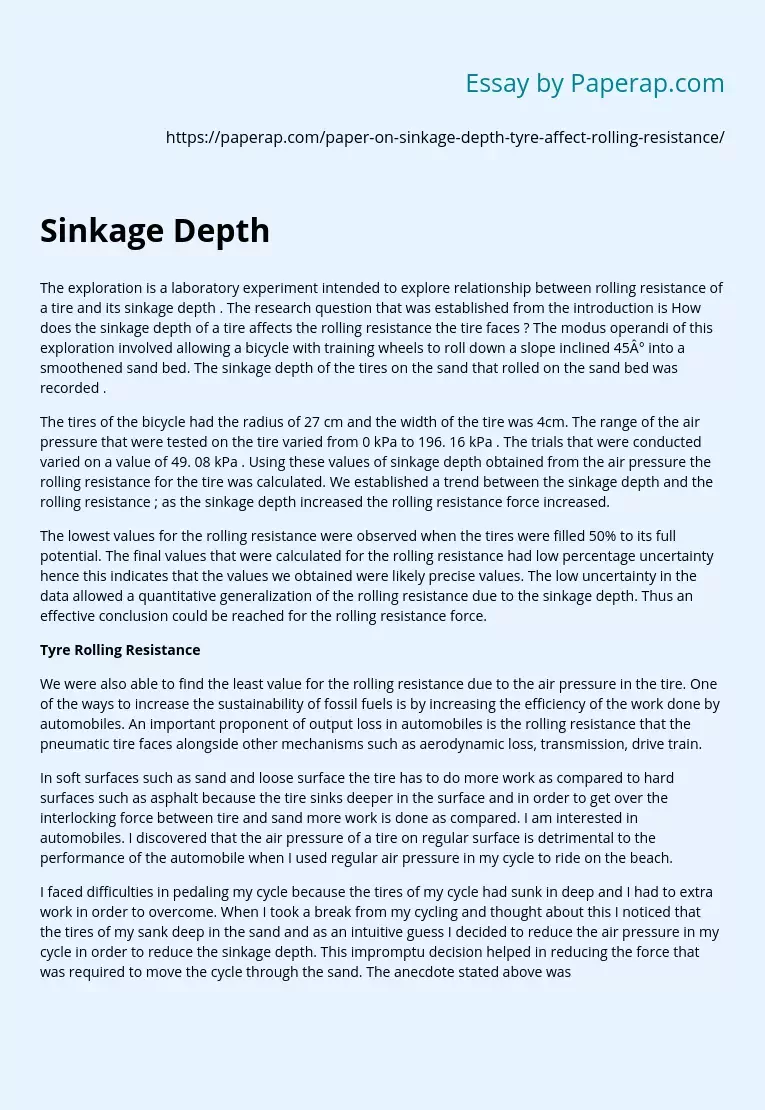Relationship Between Tire Rolling Resistance and Subsidence Depth
The following sample essay talks about study of the relationship between the rolling resistance of a tire and the depth of its subsidence. To read the introduction, body, and conclusion of the essay, scroll down.
The exploration is a laboratory experiment intended to explore relationship between rolling resistance of a tire and its sinkage depth . The research question that was established from the introduction is How does the sinkage depth of a tire affects the rolling resistance the tire faces ? The modus operandi of this exploration involved allowing a bicycle with training wheels to roll down a slope inclined 45° into a smoothened sand bed.
The sinkage depth of the tires on the sand that rolled on the sand bed was recorded .
The tires of the bicycle had the radius of 27 cm and the width of the tire was 4cm. The range of the air pressure that were tested on the tire varied from 0 kPa to 196. 16 kPa . The trials that were conducted varied on a value of 49.
08 kPa . Using these values of sinkage depth obtained from the air pressure the rolling resistance for the tire was calculated. We established a trend between the sinkage depth and the rolling resistance ; as the sinkage depth increased the rolling resistance force increased.
The lowest values for the rolling resistance were observed when the tires were filled 50% to its full potential. The final values that were calculated for the rolling resistance had low percentage uncertainty hence this indicates that the values we obtained were likely precise values.
The low uncertainty in the data allowed a quantitative generalization of the rolling resistance due to the sinkage depth. Thus an effective conclusion could be reached for the rolling resistance force.
Tyre Rolling Resistance
We were also able to find the least value for the rolling resistance due to the air pressure in the tire. One of the ways to increase the sustainability of fossil fuels is by increasing the efficiency of the work done by automobiles. An important proponent of output loss in automobiles is the rolling resistance that the pneumatic tire faces alongside other mechanisms such as aerodynamic loss, transmission, drive train.
In soft surfaces such as sand and loose surface the tire has to do more work as compared to hard surfaces such as asphalt because the tire sinks deeper in the surface and in order to get over the interlocking force between tire and sand more work is done as compared. I am interested in automobiles. I discovered that the air pressure of a tire on regular surface is detrimental to the performance of the automobile when I used regular air pressure in my cycle to ride on the beach.
I faced difficulties in pedaling my cycle because the tires of my cycle had sunk in deep and I had to extra work in order to overcome. When I took a break from my cycling and thought about this I noticed that the tires of my sank deep in the sand and as an intuitive guess I decided to reduce the air pressure in my cycle in order to reduce the sinkage depth. This impromptu decision helped in reducing the force that was required to move the cycle through the sand. The anecdote stated above was my premier inspiration towards my focus in my extended essay.
How does the sinkage depth of the tire on sand bed affect the rolling the cycle faces? Although the rolling resistance of the tire of an automobile is dependent on various factors, major components of rolling friction are often seen as the air pressure, temperature of the surface, The air pressure of the tire determines the surface area of the tire that comes in contact with the surface of the road as a counter-result of inflated tire; deflation. Larger tires, require more rubber and more material, the width of the tire determines how much of the tire is involved with trolling resistance.
Larger tires will have more surface area than the tires. The field of rolling resistance has been widely researched and analyzed. The most common laboratory test measures the force required to rotate a tire at the speed of 50mph against large diameter steel drum. Multiple samples of each tire /size are tested to establish an average rolling resistance value. The rolling resistance in a tire typically declines moderately as the tire temperature rise from cold to normal operating conditions during the first 30 minutes of driving every time the vehicle is used.
Relationship Between Tire Rolling Resistance and Subsidence Depth. (2019, Dec 05). Retrieved from https://paperap.com/paper-on-sinkage-depth-tyre-affect-rolling-resistance/

